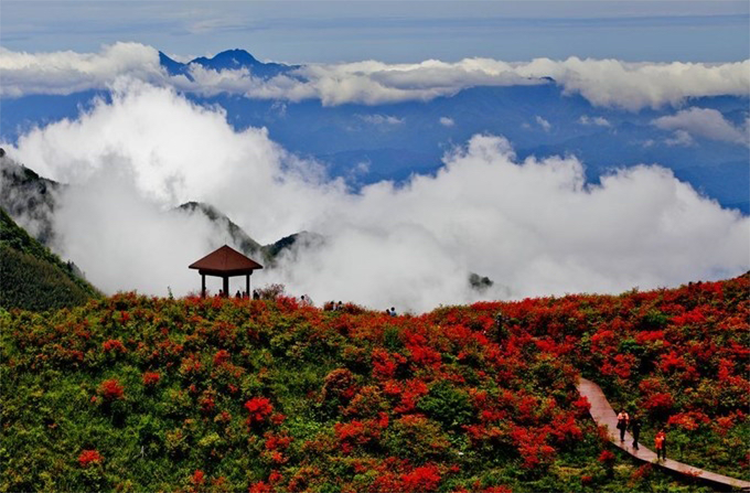Explore the Granite Peaks of Seven Star Ridge: Rhododendrons, Scenic Views & Red History
Introduction
When the first morning light slips through a sea of clouds, seven granite pinnacles scatter like giant chess pieces atop the Luoxiao Mountains. Locally celebrated in the Pingxiang County Gazetteer as “seven peaks arrayed like stars,” Seven Star Ridge (Qixingling) is a natural museum carved by 130 million years of geology and six centuries of human history. Whether you come to study Quaternary-era rock formations, lose yourself in April’s high-mountain rhododendron seas, or trace the Red Army’s training grounds and carved slogans, this 1,300-meter sanctuary gives you every reason to lace up your hiking boots.
1. A Natural Epic Written in Granite
The spirit of Seven Star Ridge was forged from ancient granite. Magma from the Yanshan tectonic events solidified and, over millennia of glaciation, wind and frost, the landscape evolved into a “natural sculpture park.” The cluster of peaks named “Seven Star Rocks” seems as if the Big Dipper descended to earth, while the well-known “Immortal Chess” formation turns two ten-meter monoliths into eternal chess players—on misty mornings you can almost imagine the click of a supernatural move.
April and May are the best months to visit. Tens of thousands of rhododendrons explode in bloom along the granite folds, bathing the peaks in a sea of pink and purple. After rain, a cloud sea often fills the mid-slopes, leaving the summits like islands floating above a silver ocean. Photographers stake out the glass viewing platform for the iconic “Seven Stars on the Waves” shots.
2. A Triad of Cultural Layers
Beneath the granite’s austere lines lie stacked layers of human memory. The highest summit, Yuhuang Peak, preserves remnants of a Ming-dynasty sacrificial altar—charred stone slabs attest to centuries of Taoist incense and the ascetic practices once described in Qing-era county records, suggesting the ridge was an important Taoist retreat.
In 1930, warfare added a red layer to the ridge’s story. During the Xianggan Revolutionary Base period, the Red Army used the rugged terrain for training, and slogans carved into the granite remain visible. Locals recall that guerrillas exploited the complex topography around the “Immortal Chess” boulders to evade pursuing forces.
3. Balancing Modern Facilities with Wild Character
As a national 4A scenic area, Seven Star Ridge strikes an artful balance between conservation and visitor experience. A 5-kilometer aerial walkway wraps the mid-slopes like a silver ribbon; a 300-meter all-glass section gives the thrilling sensation of walking on air. Yet much of the park remains raw: about 70% of trails follow ancient stone steps, and squirrels and oriental magpie-robins often cross your path among the rhododendron thickets.
The park offers a “3-hour highlights loop”: take the shuttle from the South Gate to the Cloud Sea Viewing Deck, follow the plankway through the core Seven Star Rocks area, and return via the Red Army relics. For deeper exploration, the “Seven Peaks Traverse” is an 8-hour route that threads remote rhododendron valleys and encounters far fewer visitors—ideal for experienced hikers.

4. Practical Guide: Ways to Experience Seven Star Ridge
Transport
From downtown Pingxiang, it’s a 1.5-hour drive (navigate to “Seven Star Ridge Scenic Area South Gate”). The Shanghai–Kunming high-speed rail stops at Pingxiang North Station, where a scenic-area shuttle bus runs twice daily. Note: the last 20 kilometers are steep and winding; self-drivers are advised to use vehicles over 1.6L for comfort and safety.
Tickets and Services
Peak season (April 20–May 31) admission is ¥98 and includes the sightseeing shuttle; the glass viewing platform requires disposable shoe covers sold at the entrance for ¥5. Multilingual audio guides (Chinese/English/Japanese/Korean) are available to rent at the visitor center, though some Red Army-site interpretation remains only in Chinese. The park restaurant “Rhododendron House” serves local mountain specialties, including braised wild stone chicken prepared with cloud tea.
Accommodation Tips
For convenience, choose a foothill guesthouse such as “Starry Sky B&B” (off-season rooms from ¥200). Photography-focused visitors may prefer the mountaintop camping base—advance registration is required. Weekends in spring can be crowded; aim to enter before 8:00 a.m. on weekdays to avoid tour groups.

Conclusion
As dusk casts a golden armor over the granite, standing atop Seven Star Ridge brings into focus the meaning of “majestic, rugged, and beautiful.” Every stone here tells a chapter of Earth’s deep-time story; every patch of lichen and carved slogan bears witness to human devotion and struggle. Geology enthusiasts, history buffs, and pure nature lovers will find a personal pilgrimage among these star-like peaks. Leave a note in the visitor book—your words might become the opening line of someone else’s springtime legend.


